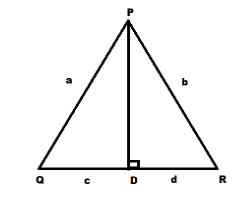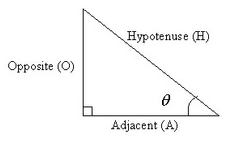
In a triangle PQR PD is perpendicular on QR such that D lies on QR. If \[PQ = a\], \[PR = b\] , \[QD = c\] and \[DR = d\],then
A) \[\left( {a - d} \right)\left( {a + d} \right) = \left( {b - c} \right)\left( {b + c} \right)\]
B) \[\left( {a - c} \right)\left( {b - d} \right) = \left( {a + c} \right)\left( {b + d} \right)\]
C) \[\left( {a - b} \right)\left( {a + b} \right) = \left( {c + d} \right)\left( {c - d} \right)\]
D) \[\left( {a - b} \right)\left( {c - d} \right) = \left( {a + b} \right)\left( {c + d} \right)\]
Answer
576.9k+ views
Hint: Firstly we will calculate the length of perpendicular in both the triangles \[\Delta PQD\] and \[\Delta PRD\] using Pythagoras formula in both the triangles and then equate its value to get the desired answer.
The Pythagoras formula is given by:-
\[{\left( {{\text{hypotenuse}}} \right)^2} = {\left( {{\text{base}}} \right)^{\text{2}}}{\text{ + }}{\left( {{\text{perpendicular}}} \right)^2}\]
The identity used is:
\[{x^2} - {y^2} = \left( {x + y} \right)\left( {x - y} \right)\]
Complete step-by-step answer:

In \[\Delta PQD\],
\[PQ = a = {\text{hypotenuse}}\]
\[QD = c = {\text{base}}\]
\[PD = {\text{ perpendicular}}\]
Applying the Pythagoras formula we get:-
\[\begin{gathered}
{\left( {{\text{hypotenuse}}} \right)^2} = {\left( {{\text{base}}} \right)^{\text{2}}}{\text{ + }}{\left( {{\text{perpendicular}}} \right)^2} \\
{a^2} = {c^2} + {\left( {{\text{perpendicular}}} \right)^2} \\
{\left( {{\text{perpendicular}}} \right)^2} = {a^2} - {c^2}.............\left( 1 \right) \\
\end{gathered} \]
In \[\Delta PRD\],
\[\begin{gathered}
PR = b = {\text{hypotenuse}} \\
QR = d = {\text{base}} \\
PD = {\text{ perpendicular}} \\
\end{gathered} \]
Applying the Pythagoras formula we get:-
\[\begin{gathered}
{\left( {{\text{hypotenuse}}} \right)^2} = {\left( {{\text{base}}} \right)^{\text{2}}}{\text{ + }}{\left( {{\text{perpendicular}}} \right)^2} \\
{b^2} = {d^2} + {\left( {{\text{perpendicular}}} \right)^2} \\
{\left( {{\text{perpendicular}}} \right)^2} = {b^2} - {d^2}.............\left( 2 \right) \\
\end{gathered} \]
Equating equations 1 and 2 we get:-
\[\begin{gathered}
\Rightarrow {a^2} - {c^2} = {b^2} - {d^2} \\
\Rightarrow {a^2} - {b^2} = {c^2} - {d^2} \\
\end{gathered} \]
Now applying the following identity on both LHS and RHS:
\[{x^2} - {y^2} = \left( {x + y} \right)\left( {x - y} \right)\]
We get:-
\[\left( {a + b} \right)\left( {a - b} \right) = \left( {c + d} \right)\left( {c - d} \right)\]
Hence option (c) is the correct answer.
Note: In a right angled triangle, the longest side is hypotenuse and the sides containing the right angle are the base and the perpendicular.

The Pythagoras formula is given by:-
\[{\left( {{\text{hypotenuse}}} \right)^2} = {\left( {{\text{base}}} \right)^{\text{2}}}{\text{ + }}{\left( {{\text{perpendicular}}} \right)^2}\]
The identity used is:
\[{x^2} - {y^2} = \left( {x + y} \right)\left( {x - y} \right)\]
Complete step-by-step answer:

In \[\Delta PQD\],
\[PQ = a = {\text{hypotenuse}}\]
\[QD = c = {\text{base}}\]
\[PD = {\text{ perpendicular}}\]
Applying the Pythagoras formula we get:-
\[\begin{gathered}
{\left( {{\text{hypotenuse}}} \right)^2} = {\left( {{\text{base}}} \right)^{\text{2}}}{\text{ + }}{\left( {{\text{perpendicular}}} \right)^2} \\
{a^2} = {c^2} + {\left( {{\text{perpendicular}}} \right)^2} \\
{\left( {{\text{perpendicular}}} \right)^2} = {a^2} - {c^2}.............\left( 1 \right) \\
\end{gathered} \]
In \[\Delta PRD\],
\[\begin{gathered}
PR = b = {\text{hypotenuse}} \\
QR = d = {\text{base}} \\
PD = {\text{ perpendicular}} \\
\end{gathered} \]
Applying the Pythagoras formula we get:-
\[\begin{gathered}
{\left( {{\text{hypotenuse}}} \right)^2} = {\left( {{\text{base}}} \right)^{\text{2}}}{\text{ + }}{\left( {{\text{perpendicular}}} \right)^2} \\
{b^2} = {d^2} + {\left( {{\text{perpendicular}}} \right)^2} \\
{\left( {{\text{perpendicular}}} \right)^2} = {b^2} - {d^2}.............\left( 2 \right) \\
\end{gathered} \]
Equating equations 1 and 2 we get:-
\[\begin{gathered}
\Rightarrow {a^2} - {c^2} = {b^2} - {d^2} \\
\Rightarrow {a^2} - {b^2} = {c^2} - {d^2} \\
\end{gathered} \]
Now applying the following identity on both LHS and RHS:
\[{x^2} - {y^2} = \left( {x + y} \right)\left( {x - y} \right)\]
We get:-
\[\left( {a + b} \right)\left( {a - b} \right) = \left( {c + d} \right)\left( {c - d} \right)\]
Hence option (c) is the correct answer.
Note: In a right angled triangle, the longest side is hypotenuse and the sides containing the right angle are the base and the perpendicular.

Recently Updated Pages
Master Class 9 Social Science: Engaging Questions & Answers for Success

Master Class 9 Science: Engaging Questions & Answers for Success

Master Class 9 English: Engaging Questions & Answers for Success

Master Class 9 Maths: Engaging Questions & Answers for Success

Master Class 9 General Knowledge: Engaging Questions & Answers for Success

Class 9 Question and Answer - Your Ultimate Solutions Guide

Trending doubts
Which places in India experience sunrise first and class 9 social science CBSE

Fill the blanks with the suitable prepositions 1 The class 9 english CBSE

Write the 6 fundamental rights of India and explain in detail

Difference Between Plant Cell and Animal Cell

What is pollution? How many types of pollution? Define it

What is the Full Form of ISI and RAW




